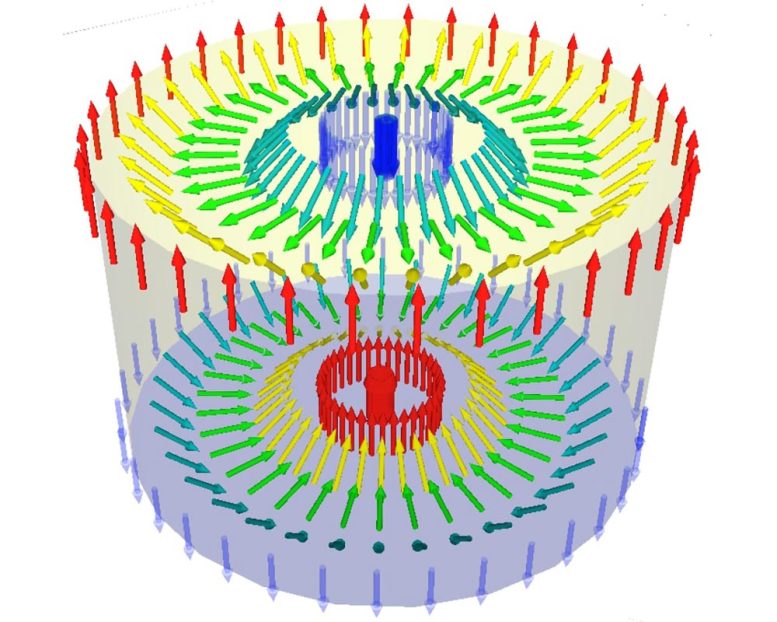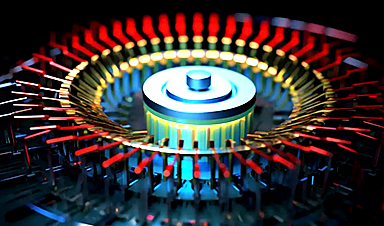Researchers in Germany and Japan have been able to increase the diffusion of magnetic whirls, so-called skyrmions, by a factor of ten.
In today's world, our lives are unimaginable without computers. Up until now, these devices process information using primarily electrons as charge carriers, with the components themselves heating up significantly in the process. Active cooling is thus necessary, which comes with high energy costs. Spintronics aims to solve this problem: Instead of utilizing the electron flow for information processing, it relies on their spin or their intrinsic angular momentum. This approach is expected to have a positive impact on the size, speed, and sustainability of computers or specific components.
Magnetic Whirls Store and Process Information
Science often does not simply consider the spin of an individual electron, but rather magnetic whirls composed of numerous spins. These whirls called skyrmions emerge in magnetic metallic thin layers and can be considered as two-dimensional quasi-particles. On the one hand, the whirls can be deliberately moved by applying a small electric current to the thin layers; on the other hand, they move randomly and extremely efficiently due to diffusion. The feasibility of creating a functional computer based on skyrmions was demonstrated by a team of researchers from Johannes Gutenberg University Mainz (JGU), led by Professor Dr. Mathias Kläui, using an initial prototype. This prototype consisted of thin, stacked metallic layers, some only a few atomic layers thick.

Two skyrmions antiferromagnetically coupled: The spin in the center and the outside spins are antiparallel to each other. Credit: ill./©: Takaaki Dohi / Tohoku University
Boosting Energy Efficiency
In collaboration with the University of Konstanz and Tohoku University in Japan, researchers of Mainz University have now achieved another step towards spin-based, unconventional computing: They were able to increase the diffusion of skyrmions by a factor of about ten using synthetic antiferromagnets, which drastically reduces the energy consumption and increases the speed of such a potential computer. "The reduction of energy usage in electronic devices is one of the biggest challenges in fundamental research," emphasized Professor Dr. Ulrich Nowak, who led the theoretical part of the project in Konstanz.
The Power of Antiferromagnets
But what is an antiferromagnet and what is it used for? Normal ferromagnets consist of many small spins, all coupled together to point in the same direction, thereby creating a large magnetic moment. In antiferromagnets, the spins are aligned alternatingly antiparallel, i.e., a spin and its direct neighbors point in the opposite direction. As a result, there is no net magnetic moment, even though the spins remain antiferromagnetically well-ordered. Antiferromagnets have significant advantages, such as three magnitudes of faster dynamics for switching, better stability, and the potential for higher storage densities. These properties are intensively studied in multiple research projects.
In order to understand why these antiferromagnets are useful in this context, we need to delve a bit deeper. When skyrmions move very rapidly, an additional force component arises in ferromagnetic layers perpendicular to the direction of motion. This force component pushes the skyrmions off course. Consequently, they end up colliding with the wall, getting stuck, and obstructing the path for others. At higher speeds, they can even be destroyed. However, it is theoretically known that this effect either does not occur in antiferromagnets or it occurs to a very limited extent.
Advancements in Synthetic Antiferromagnets
To create such an antiferromagnet artificially, the researchers coupled two of their ferromagnetic layers in a way that the magnetization in the two layers is precisely aligned in opposite directions, canceling out their magnetic fields. This provides two advantages: They reduce the force pushing the whirls off their path and thus increase the diffusion. "With this, we have created a synthetic antiferromagnet in which the diffusion of skyrmions is approximately ten times higher than in the individual layers," said Klaus Raab, a physicist at JGU. "This diffusion can be implemented to realize stochastic computing – a form of computing where stochastic processes like the random motion of particles are utilized."
The team of researchers investigated the effects of the compensation of the magnetic layers in addition to the influence of temperature and size of the skyrmions on diffusion and consequently on the motion of the skyrmions, both experimentally and through simulations. Intricate connections have been found: As temperature rises, the skyrmions have more energy to diffuse faster. The heat also reduces the size of the skyrmions, which positively affects their mobility. The compensation of the vertical force component also has a positive impact on diffusion. All these effects are difficult to disentangle from each other. "The increasing diffusion seems to be attributable not only to the pure compensation of the magnetic fields but also to the associated reduction in the size of the skyrmions," summarized Raab.
Professor Mathias Kläui, who led the study, is pleased with the fruitful collaboration with Tohoku University: "We have been working with this leading Japanese university for about ten years and there are even joint study programs. With the support of the German Academic Exchange Service – the DAAD – and other research funders, over a dozen students from Mainz University have already participated in exchanges with Tohoku University. I am delighted that this collaborative effort has been made possible through this cooperation."
The research results have been published recently in the journal Nature Communications.
Reference: "Enhanced thermally-activated skyrmion diffusion with tunable effective gyrotropic force" by Takaaki Dohi, Markus Weißenhofer, Nico Kerber, Fabian Kammerbauer, Yuqing Ge, Klaus Raab, Jakub Zázvorka, Maria-Andromachi Syskaki, Aga Shahee, Moritz Ruhwedel, Tobias Böttcher, Philipp Pirro, Gerhard Jakob, Ulrich Nowak and Mathias Kläui, 11 September 2023, Nature Communications.
DOI: 10.1038/s41467-023-40720-0
News
Scientists Melt Cancer’s Hidden “Power Hubs” and Stop Tumor Growth
Researchers discovered that in a rare kidney cancer, RNA builds droplet-like hubs that act as growth control centers inside tumor cells. By engineering a molecular switch to dissolve these hubs, they were able to halt cancer [...]
Platelet-inspired nanoparticles could improve treatment of inflammatory diseases
Scientists have developed platelet-inspired nanoparticles that deliver anti-inflammatory drugs directly to brain-computer interface implants, doubling their effectiveness. Scientists have found a way to improve the performance of brain-computer interface (BCI) electrodes by delivering anti-inflammatory drugs directly [...]
After 150 years, a new chapter in cancer therapy is finally beginning
For decades, researchers have been looking for ways to destroy cancer cells in a targeted manner without further weakening the body. But for many patients whose immune system is severely impaired by chemotherapy or radiation, [...]
Older chemical libraries show promise for fighting resistant strains of COVID-19 virus
SARS‑CoV‑2, the virus that causes COVID-19, continues to mutate, with some newer strains becoming less responsive to current antiviral treatments like Paxlovid. Now, University of California San Diego scientists and an international team of [...]
Lower doses of immunotherapy for skin cancer give better results, study suggests
According to a new study, lower doses of approved immunotherapy for malignant melanoma can give better results against tumors, while reducing side effects. This is reported by researchers at Karolinska Institutet in the Journal of the National [...]
Researchers highlight five pathways through which microplastics can harm the brain
Microplastics could be fueling neurodegenerative diseases like Alzheimer's and Parkinson's, with a new study highlighting five ways microplastics can trigger inflammation and damage in the brain. More than 57 million people live with dementia, [...]
Tiny Metal Nanodots Obliterate Cancer Cells While Largely Sparing Healthy Tissue
Scientists have developed tiny metal-oxide particles that push cancer cells past their stress limits while sparing healthy tissue. An international team led by RMIT University has developed tiny particles called nanodots, crafted from a metallic compound, [...]
Gold Nanoclusters Could Supercharge Quantum Computers
Researchers found that gold “super atoms” can behave like the atoms in top-tier quantum systems—only far easier to scale. These tiny clusters can be customized at the molecular level, offering a powerful, tunable foundation [...]
A single shot of HPV vaccine may be enough to fight cervical cancer, study finds
WASHINGTON -- A single HPV vaccination appears just as effective as two doses at preventing the viral infection that causes cervical cancer, researchers reported Wednesday. HPV, or human papillomavirus, is very common and spread [...]
New technique overcomes technological barrier in 3D brain imaging
Scientists at the Swiss Light Source SLS have succeeded in mapping a piece of brain tissue in 3D at unprecedented resolution using X-rays, non-destructively. The breakthrough overcomes a long-standing technological barrier that had limited [...]
Scientists Uncover Hidden Blood Pattern in Long COVID
Researchers found persistent microclot and NET structures in Long COVID blood that may explain long-lasting symptoms. Researchers examining Long COVID have identified a structural connection between circulating microclots and neutrophil extracellular traps (NETs). The [...]
This Cellular Trick Helps Cancer Spread, but Could Also Stop It
Groups of normal cbiells can sense far into their surroundings, helping explain cancer cell migration. Understanding this ability could lead to new ways to limit tumor spread. The tale of the princess and the [...]
New mRNA therapy targets drug-resistant pneumonia
Bacteria that multiply on surfaces are a major headache in health care when they gain a foothold on, for example, implants or in catheters. Researchers at Chalmers University of Technology in Sweden have found [...]
Current Heart Health Guidelines Are Failing To Catch a Deadly Genetic Killer
New research reveals that standard screening misses most people with a common inherited cholesterol disorder. A Mayo Clinic study reports that current genetic screening guidelines overlook most people who have familial hypercholesterolemia, an inherited disorder that [...]
Scientists Identify the Evolutionary “Purpose” of Consciousness
Summary: Researchers at Ruhr University Bochum explore why consciousness evolved and why different species developed it in distinct ways. By comparing humans with birds, they show that complex awareness may arise through different neural architectures yet [...]
Novel mRNA therapy curbs antibiotic-resistant infections in preclinical lung models
Researchers at the Icahn School of Medicine at Mount Sinai and collaborators have reported early success with a novel mRNA-based therapy designed to combat antibiotic-resistant bacteria. The findings, published in Nature Biotechnology, show that in [...]





















